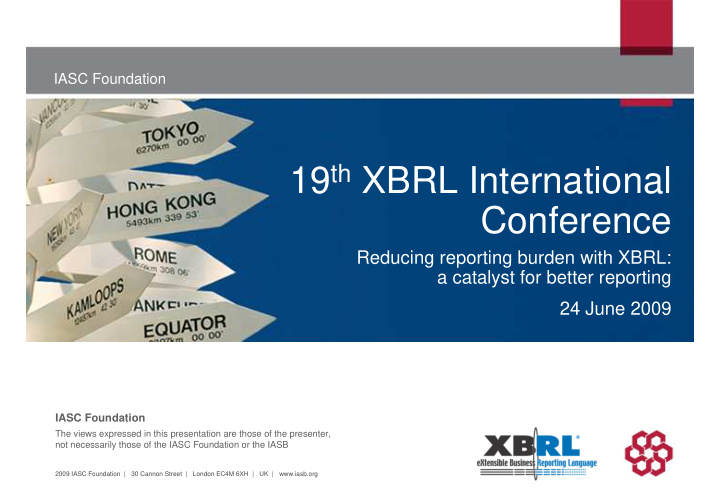



IASC Foundation 19 th XBRL International Conference Reducing reporting burden with XBRL: a catalyst for better reporting 24 June 2009 IASC Foundation The views expressed in this presentation are those of the presenter, not necessarily those of the IASC Foundation or the IASB 2009 IASC Foundation | 30 Cannon Street | London EC4M 6XH | UK | www.iasb.org
IASC Foundation IFRSs in XBRL for users: How IFRS reporting in XBRL can deliver better results for analysts and investors IASC Foundation The views expressed in this presentation are those of the presenter, not necessarily those of the IASC Foundation or the IASB 2009 IASC Foundation | 30 Cannon Street | London EC4M 6XH | UK | www.iasb.org
THOMSON REUTERS 19 TH XBRL CONFERENCE Case Study on processing Japanese GAAP XBRL Lessons for IFRS GEOFFREY HORRELL 24 TH JUNE 2009
INTRODUCING THOMSON REUTERS •We provide intelligent information to the world’s businesses and professionals , giving our customers a competitive advantage . Professional Division Markets Division $5.5 billion $7.9 billion 23,100 employees 27,220 employees Legal Tax & Healthcare & Investment Sales & Enterprise Media Accounting Science & Advisory Trading $3.5 B $0.9 B $1.1 B $2.4 B $3.8 B $1.3 B $0.4 B “We make “We reduce “We accelerate legal systems complexity and research, work better” make discovery and “We power the worlds markets” compliance innovation” easier” 2008 Revenues
XBRL Implementation Case Study Project Aim “Harness XBRL to deliver faster and more reliable standardized data within Thomson Reuters existing fundamentals offering”
Japanese XBRL Project Thomson Reuters has a large client base in Japan and many ‘outside-in’ investors around the world so Japan offered an excellent opportunity to make the difference to clients through XBRL Faster In Japan 5,000 public companies file in a matter of days, making it hard to deliver timely data without huge resources. Real-time delivery of XBRL Tanshins is available via TDNET More Reliable Mapping data to internal codes is done manually by multiple analysts across companies and time The Japanese GAAP Taxonomy can be mapped to the internal codes centrally ensuring no manual errors. A large sample set for testing is available - over 4,000 XBRL documents *Although Yuhos are more complete documents, there is no automated feed and the documents are filed after the Tanshins
Process Steps 1. Document Management 2. XBRL Parsing 3. Mapping to COA codes 4. Store the XBRL 5. Transform & Load the data 6. Manual Entry 7. Exception Handling Thomson Reuters worked with Rivet Software for core XBRL components
Project Scorecard & Lessons • Delivering faster data to clients The project was successful in delivering a massive increase in speed Flash updates of core financial items are released in minutes versus hours • Delivering more reliable data to clients Over 90% of elements, including company specific extensions were mapped to the standardized template
Project Scorecard & Lessons - continued All Investment is based on relative valuations. This requires comparability between periods, companies, countries and industries Standardization still requires manual footnote collection 24 Industry Templates added complexity! Re-used elements need to be handled carefully About 10% of the elements have to be manually mapped No prior periods were provided within the XBRL instance
Conclusion • XBRL can easily be used to enhance existing systems • To serve the investment audience the XBRL Community should work towards: – inclusion of press releases with fast delivery mechanisms within mandates – Taxonomies that include the presentation of textual data as well as financial and strike a balance between flexibility & standardization – Mandates for footnote items and non-GAAP disclosures
Appendix – Tanshins vs. Yuhos in Japan • Tanshin – Delivered in real-time via TDNET – Preliminary filings provided 4 times a year – 2 Page summary, PDF and XBRL delivered in single zip file – 70% of listed companies are filing Tanshins in XBRL – Provides 150-250 data elements • Yuho – Delivered to EDINET website in electronic format – Filed 4 times a year after the Tanshin. – Provides 300-400 data elements – There is a mandatory requirement to file Yuhos and Annual Tanshins in 2009
Recommend
More recommend